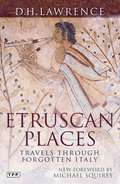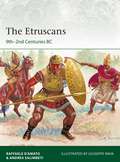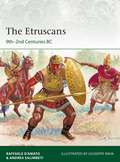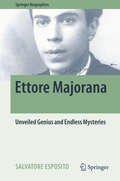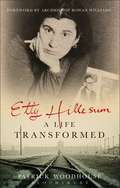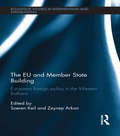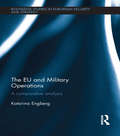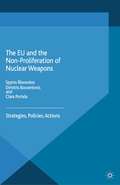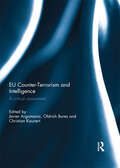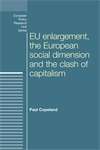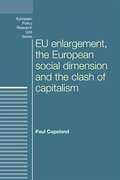- Table View
- List View
Etienne Decroux and his Theatre Laboratory (Routledge Icarus Ser.)
by Marco de MarinisEtienne Decroux and His Theatre Laboratory is based on the long-awaited translation of Marco De Marinis' monumental work on mime in the twentieth century: Mimo e teatro nel Novecento (1993). Now revised and updated, the volume focuses specifically on the seminal role played by French mime artist and pedagogue Etienne Decroux. Mime is a theatrical form of ancient tradition. In the nineteenth century, it saw both apogee and crisis in the west with the realistic and gesticulating 'white pantomime'. In the twentieth century, it underwent a radical overhaul, transforming into an 'abstract' corporeal art that shunned imitation and narrative, and which instead tended towards the plastic, elliptic, allusive, and symbolic transposition of actions and situations. This book is the result of detailed investigations, based on contemporary accounts and obscure or unpublished materials. Through the examination of the creative, pedagogical, and theoretical work of the 'inventor' of the new mime art, Etienne Decroux, De Marinis focuses on the different assumptions underlying the various modes of the problematic presence of mime in the theatre of the twentieth century: from the utopia of a 'pure' theatre, attributed to the sole essence of the actor, to its decline into a closed poetic genre often nostalgically stuck in the past; from mime as a pedagogical tool for the actor to mime as an expressive and virtuosic means in the hands of the director.
Etienne Decroux and his Theatre Laboratory (Routledge Icarus Ser.)
by Marco de MarinisEtienne Decroux and His Theatre Laboratory is based on the long-awaited translation of Marco De Marinis' monumental work on mime in the twentieth century: Mimo e teatro nel Novecento (1993). Now revised and updated, the volume focuses specifically on the seminal role played by French mime artist and pedagogue Etienne Decroux. Mime is a theatrical form of ancient tradition. In the nineteenth century, it saw both apogee and crisis in the west with the realistic and gesticulating 'white pantomime'. In the twentieth century, it underwent a radical overhaul, transforming into an 'abstract' corporeal art that shunned imitation and narrative, and which instead tended towards the plastic, elliptic, allusive, and symbolic transposition of actions and situations. This book is the result of detailed investigations, based on contemporary accounts and obscure or unpublished materials. Through the examination of the creative, pedagogical, and theoretical work of the 'inventor' of the new mime art, Etienne Decroux, De Marinis focuses on the different assumptions underlying the various modes of the problematic presence of mime in the theatre of the twentieth century: from the utopia of a 'pure' theatre, attributed to the sole essence of the actor, to its decline into a closed poetic genre often nostalgically stuck in the past; from mime as a pedagogical tool for the actor to mime as an expressive and virtuosic means in the hands of the director.
Etrog: How A Chinese Fruit Became a Jewish Symbol
by David Z. MosterEvery year before the holiday of Sukkot, Jews all around the world purchase an etrog—a lemon-like fruit—to participate in the holiday ritual. In this book, David Z. Moster tracks the etrog from its evolutionary home in Yunnan, China, to the lands of India, Iran, and finally Israel, where it became integral to the Jewish celebration of Sukkot during the Second Temple period. Moster explains what Sukkot was like before and after the arrival of the etrog, and why the etrog’s identification as the “choice tree fruit” of Leviticus 23:40 was by no means predetermined. He also demonstrates that once the fruit became associated with the holiday of Sukkot, it began to appear everywhere in Jewish art during the Roman and Byzantine periods, and eventually became a symbol for all the fruits of the land, and perhaps even the Jewish people as a whole.
Etrog: How A Chinese Fruit Became a Jewish Symbol
by David Z. MosterEvery year before the holiday of Sukkot, Jews all around the world purchase an etrog—a lemon-like fruit—to participate in the holiday ritual. In this book, David Z. Moster tracks the etrog from its evolutionary home in Yunnan, China, to the lands of India, Iran, and finally Israel, where it became integral to the Jewish celebration of Sukkot during the Second Temple period. Moster explains what Sukkot was like before and after the arrival of the etrog, and why the etrog’s identification as the “choice tree fruit” of Leviticus 23:40 was by no means predetermined. He also demonstrates that once the fruit became associated with the holiday of Sukkot, it began to appear everywhere in Jewish art during the Roman and Byzantine periods, and eventually became a symbol for all the fruits of the land, and perhaps even the Jewish people as a whole.
Etruscan Places: Travels Through Forgotten Italy
by D. H. LawrenceYou cannot think of art, only of life itself, as if this were the very life of the Etruscans, dancing with naked limbs, ruddy from the air and the sea-light, dancing and fluting along through the olive trees, out in the fresh day.'The Etruscan civilisation, which flourished from the 8th until the 5th century BC in what is now Tuscany, is one of the most fascinating and mysterious in history. An uninhibited, elemental people, the Etruscans enthralled D.H. Lawrence, who craved their 'old wisdom', the secret of their vivacity and love of life. To him they represented the antithesis of everything he despised in the modern world, perhaps because their spontaneity and naturalness struck a chord with his own quest for personal and artistic freedom - so often censured or repressed. Lawrence approaches the enigmatic Etruscans as a poet, passionately and searchingly, and so the reader is swept up in his luminous descriptions of a utopian world where dancing and feasting, art and music were everything. The exhilaration of Lawrence in his Etruscan adventures stands in stark contrast to his intimations of the darkness of Mussolini's Italy - at a time when Europe was beginning its inexorable drift towards tragedy.The last of Lawrence's travel books, Etruscan Places is an ethereal and vivid account, replete with hauntingly evocative descriptions of the way of life of this once great civilisation.
Etruscan Roman Remains
by LelandCast a spell against gossips, deflect unwanted romantic attention, or bring the dead back to life. The renowned 19th-century folklorist and expert on witchy cultures Charles Leland believed he had uncovered the secrets of practical domestic magic as the ancient pagans of Italian Tuscany performed it, and he shared all in this classic 1892 study. Considered by the author to be his own masterwork, this enthralling work--one still the subject of heated debate among modern pagans, some of whom embrace it while others deny its accuracy--here are detailed examinations of the "gods and goblins" of the region as well as the time-honored incantations, divinations, medicines, and amulets of the Tuscans.
Etruscan Roman Remains
by LelandCast a spell against gossips, deflect unwanted romantic attention, or bring the dead back to life. The renowned 19th-century folklorist and expert on witchy cultures Charles Leland believed he had uncovered the secrets of practical domestic magic as the ancient pagans of Italian Tuscany performed it, and he shared all in this classic 1892 study. Considered by the author to be his own masterwork, this enthralling work--one still the subject of heated debate among modern pagans, some of whom embrace it while others deny its accuracy--here are detailed examinations of the "gods and goblins" of the region as well as the time-honored incantations, divinations, medicines, and amulets of the Tuscans.
The Etruscans: 9th–2nd Centuries BC (Elite #223)
by Giuseppe Rava Andrea Salimbeti Dr Raffaele D’AmatoAncient Rome had deep roots in the 'Villanovan' culture that we call today the Etruscans. Their long-lived civilization can be traced to 900–750 BC in north-west Italy. They were a sea-faring people trading with and competing against Greek and Phoenician peoples, including the Carthaginians. They were also a great land-based power, especially in the 'Classical' period, where they expanded their power north into the Po Valley and south to Latium. In the 6th century BC an Etruscan dynasty ruled Rome, and their power extended southwards to the Amalfi coast. In 509 BC the Romans rose up to expel their kings, which began the long 'Etruscan twilight' when their power was squeezed by the Samnites and, most especially, the Romans. Drawing on archaeological evidence including warrior tombs, paintings, sculptures, and fully illustrated throughout, this study examines one of the early rivals to Ancient Rome.
The Etruscans: 9th–2nd Centuries BC (Elite)
by Giuseppe Rava Andrea Salimbeti Raffaele D’AmatoAncient Rome had deep roots in the 'Villanovan' culture that we call today the Etruscans. Their long-lived civilization can be traced to 900–750 BC in north-west Italy. They were a sea-faring people trading with and competing against Greek and Phoenician peoples, including the Carthaginians. They were also a great land-based power, especially in the 'Classical' period, where they expanded their power north into the Po Valley and south to Latium. In the 6th century BC an Etruscan dynasty ruled Rome, and their power extended southwards to the Amalfi coast. In 509 BC the Romans rose up to expel their kings, which began the long 'Etruscan twilight' when their power was squeezed by the Samnites and, most especially, the Romans. Drawing on archaeological evidence including warrior tombs, paintings, sculptures, and fully illustrated throughout, this study examines one of the early rivals to Ancient Rome.
The Etruscans and the History of Dentistry: The Golden Smile through the Ages (Routledge Monographs in Classical Studies)
by Marshall J. Becker Jean MacIntosh TurfaThe Etruscans and the History of Dentistry offers a study of the construction and use of gold dental appliances in ancient Etruscan culture, and their place within the framework of a general history of dentistry, with special emphasis on appliances, from Bronze Age Mesopotamia and Egypt to modern Europe and the Americas. Included are many of the ancient literary sources that refer to dentistry - or the lack thereof - in Greece and Rome, as well as the archaeological evidence of ancient dental health. The book challenges many past works in exposing modern scholars’ fallacies about ancient dentistry, while presenting the incontrovertible evidence of the Etruscans’ seemingly modern attitudes to cosmetic dentistry.
The Etruscans and the History of Dentistry: The Golden Smile through the Ages (Routledge Monographs in Classical Studies)
by Marshall J. Becker Jean MacIntosh TurfaThe Etruscans and the History of Dentistry offers a study of the construction and use of gold dental appliances in ancient Etruscan culture, and their place within the framework of a general history of dentistry, with special emphasis on appliances, from Bronze Age Mesopotamia and Egypt to modern Europe and the Americas. Included are many of the ancient literary sources that refer to dentistry - or the lack thereof - in Greece and Rome, as well as the archaeological evidence of ancient dental health. The book challenges many past works in exposing modern scholars’ fallacies about ancient dentistry, while presenting the incontrovertible evidence of the Etruscans’ seemingly modern attitudes to cosmetic dentistry.
Ettore Majorana: Unveiled Genius and Endless Mysteries (Springer Biographies #159)
by Salvatore Esposito Laura Gentile de FraiaThis biography sheds new light on the life and work of physicist Ettore Majorana (including unpublished contributions), as well as on his mysterious disappearance in March 1938. Majorana is held by many, including Nobel Laureate, Enrico Fermi, to have been a genius of the rank of Galilei and Newton. In this intriguing story, the author, himself a leading expert on the work of Majorana, supplements the existing literature with new insights, anecdotes and personal accounts of contemporaries of Majorana.
Etty Hillesum: A Life Transformed
by Patrick WoodhouseOn 8 March 1941, a 27-year-old Jewish Dutch student living in Nazi-occupied Amsterdam made the first entry in a diary that was to become one of the most remarkable documents to emerge from the Nazi Holocaust. Over the course of the next two and a half years, an insecure, chaotic and troubled young woman was transformed into someone who inspired those with whom she shared the suffering of the transit camp at Westerbork and with whom she eventually perished at Auschwitz. Through her diary and letters, she continues to inspire those whose lives she has touched since. She was an extraordinarily alive and vivid young woman who shaped and lived a spirituality of hope in the darkest period of the twentieth century. This book explores Etty Hillesum's life and writings, seeking to understand what it was about her that was so remarkable, how her journey developed, how her spirituality was shaped, and what her profound reflections on the roots of violence and the nature of evil can teach us today.
The Etymologicon: A Circular Stroll through the Hidden Connections of the English Language
by Mark ForsythTHE SUNDAY TIMES NUMBER ONE BESTSELLER. 'Witty and erudite ... stuffed with the kind of arcane information that nobody strictly needs to know, but which is a pleasure to learn nonetheless.' Nick Duerden, Independent. 'Particularly good ... Forsyth takes words and draws us into their, and our, murky history.' William Leith, Evening Standard. The Etymologicon is an occasionally ribald, frequently witty and unerringly erudite guided tour of the secret labyrinth that lurks beneath the English language. What is the actual connection between disgruntled and gruntled? What links church organs to organised crime, California to the Caliphate, or brackets to codpieces? Mark Forsyth's riotous celebration of the idiosyncratic and sometimes absurd connections between words is a classic of its kind: a mine of fascinating information and a must-read for word-lovers everywhere. 'Highly recommended' Spectator.
Etymologies And Genealogies (PDF): A Literary Anthropology Of The French Middle Ages
by R. Howard Bloch"Mr. Bloch has attempted to establish what he calls a 'literary anthropology.' The project is important and ambitious. It seems to me that Mr. Bloch has completely achieved this ambition." –Michel Foucault "Bloch's Study is a genuinely interdisciplinary one, bringing together elements of history, ethnology, philology, philosophy, economics and literature, with the undoubted ambition of generating a new synthesis which will enable us to read the Middle Ages in a different light. Stated simply, and in terms which do justice neither to the density nor the subtlety of his argument, Bloch's thesis is this: that medieval society perceived itself in terms of a vertical mode of descent from origins. This model is articulated etymologically in medieval theories of grammar and language, and is consequently reflected in historical and theological writings; it is also latent in the genealogical structure of the aristocratic family as it began to be organized in France in the twelfth century, and is made manifest in such systems of signs as heraldry and the adoption of patronymns. . . .
The EU and Member State Building: European Foreign Policy in the Western Balkans (Routledge Studies in Intervention and Statebuilding)
by Soeren Keil Zeynep ArkanThis book critically examines the process of statebuilding by the EU, focusing on its attempts to build Member States in the Western Balkan region. This book analyses the European Union's policies towards, and the impact they have, upon the states of the Western Balkans, and assesses how these affect the nature of EU foreign policy. To this end, it focuses on the tools and mechanisms that the EU employs in its enlargement policy and examines the new instruments of direct intervention (in Bosnia and Kosovo), political coercion (in the case of Croatia and Serbia in relation to the International Criminal Tribunal for the former Yugoslavia), and stricter conditionality in the Western Balkan countries. The book discusses the key aim of this special form of statebuilding, which is to establish functional liberal-democratic states in Albania, Bosnia and Herzegovina, Croatia, Kosovo, Macedonia, Montenegro, and Serbia in order for them to join the EU and to cope with the responsibilities and pressures of membership in the future. However, the authors argue that while the EU sees itself as an international actor that promotes and protects liberal-democratic values, norms and principles, its experiences in the Western Balkans demonstrate how the EU´s actions in the region have undermined the basic principles of democratic decision-making (such as the European support for impositions in Bosnia) and international law (Kosovo), and have consequently contributed to new tensions (see police reform in Bosnia, and the tensions between Kosovo and Serbia) and dependencies. This book will be of much interest to students of statebuilding, EU politics, global governance and IR/Security Studies in general.
The EU and Member State Building: European Foreign Policy in the Western Balkans (Routledge Studies in Intervention and Statebuilding)
by Soeren Keil Zeynep ArkanThis book critically examines the process of statebuilding by the EU, focusing on its attempts to build Member States in the Western Balkan region. This book analyses the European Union's policies towards, and the impact they have, upon the states of the Western Balkans, and assesses how these affect the nature of EU foreign policy. To this end, it focuses on the tools and mechanisms that the EU employs in its enlargement policy and examines the new instruments of direct intervention (in Bosnia and Kosovo), political coercion (in the case of Croatia and Serbia in relation to the International Criminal Tribunal for the former Yugoslavia), and stricter conditionality in the Western Balkan countries. The book discusses the key aim of this special form of statebuilding, which is to establish functional liberal-democratic states in Albania, Bosnia and Herzegovina, Croatia, Kosovo, Macedonia, Montenegro, and Serbia in order for them to join the EU and to cope with the responsibilities and pressures of membership in the future. However, the authors argue that while the EU sees itself as an international actor that promotes and protects liberal-democratic values, norms and principles, its experiences in the Western Balkans demonstrate how the EU´s actions in the region have undermined the basic principles of democratic decision-making (such as the European support for impositions in Bosnia) and international law (Kosovo), and have consequently contributed to new tensions (see police reform in Bosnia, and the tensions between Kosovo and Serbia) and dependencies. This book will be of much interest to students of statebuilding, EU politics, global governance and IR/Security Studies in general.
The EU and Military Operations: A comparative analysis (Routledge Studies in European Security and Strategy)
by Katarina EngbergThis book is a comparative study which aims to answer the question: under what circumstances does the EU undertake military operations? Since 2003, the EU has carried out six military operations. What accounts for this historic development? The EU and Military Operations examines the dynamics behind the EU´s collective use of force and situates the EU in the context of a global division of labour with regard to military crisis management. It centres on the study of two main cases of EU military operations: the non-case when an operation was planned in the Lebanon war 2006 but did not occur, and the positive case of EUFOR RD Congo that same year. Drawing upon these findings, the author creates an innovative analytical framework based upon the techniques of defence planning, and applies this to the cases studies with the purpose of identifying the main driving and inhibiting factors behind the operations. Key findings derived from this analysis include the growing importance of local actors in facilitating or impeding the EU´s deployment of military force and the enhanced role of regional organisations as security providers. The book will be of much interest to students of European security, EU politics, strategic studies, humanitarian intervention, security studies and IR in general.
The EU and Military Operations: A comparative analysis (Routledge Studies in European Security and Strategy)
by Katarina EngbergThis book is a comparative study which aims to answer the question: under what circumstances does the EU undertake military operations? Since 2003, the EU has carried out six military operations. What accounts for this historic development? The EU and Military Operations examines the dynamics behind the EU´s collective use of force and situates the EU in the context of a global division of labour with regard to military crisis management. It centres on the study of two main cases of EU military operations: the non-case when an operation was planned in the Lebanon war 2006 but did not occur, and the positive case of EUFOR RD Congo that same year. Drawing upon these findings, the author creates an innovative analytical framework based upon the techniques of defence planning, and applies this to the cases studies with the purpose of identifying the main driving and inhibiting factors behind the operations. Key findings derived from this analysis include the growing importance of local actors in facilitating or impeding the EU´s deployment of military force and the enhanced role of regional organisations as security providers. The book will be of much interest to students of European security, EU politics, strategic studies, humanitarian intervention, security studies and IR in general.
The EU and the Non-Proliferation of Nuclear Weapons: Strategies, Policies, Actions (The European Union in International Affairs)
by Clara Portela Spyros Blavoukos Dimitris BourantonisMuch of the literature on the emerging role of the EU as a non-proliferation actor has only a minimal engagement with theory. This collection aims to rectify this by placing the role of the EU in the non-proliferation of nuclear weapons within an analytical framework inspired by emerging literature on the performance of international organisations.
EU Counter-Terrorism and Intelligence: A Critical Assessment
by Javier Argomaniz Oldrich Bures Christian KaunertThe Treaty on the European Union stipulates that one of the key objectives of the Union is to provide citizens with a high level of safety within an Area of Freedom, Security and Justice. Given that the fight against terrorism is a prominent aspect of this general objective, it is remarkable that, in spite of its political relevance and decade-long history, it has only relatively recently received due attention in the academic community. Yet an analysis of the successes and failures of the EU's involvement in this field is imperative and this is a particularly pertinent moment to take stock of progress. The goal of this book is therefore to look back at the post-9/11 period and answer the question of whether, when it comes to the measures taken to combat terrorism following these attacks, the EU has lived up to the promise made in its founding treaties. In pursuing this goal, this volume presents the views of leading experts casting a critical eye over the EU's performance, recognising achievements but also being suitably critical when the realities did not match the European rhetoric. In doing this, the book makes a significant contribution not only to the scholarly investigation of European Union policies, but also to the study of counter-terrorism in general.This book was published as a special issue of Intelligence and National Security.
EU Counter-Terrorism and Intelligence: A Critical Assessment
by Javier Argomaniz, Oldrich Bures and Christian KaunertThe Treaty on the European Union stipulates that one of the key objectives of the Union is to provide citizens with a high level of safety within an Area of Freedom, Security and Justice. Given that the fight against terrorism is a prominent aspect of this general objective, it is remarkable that, in spite of its political relevance and decade-long history, it has only relatively recently received due attention in the academic community. Yet an analysis of the successes and failures of the EU's involvement in this field is imperative and this is a particularly pertinent moment to take stock of progress. The goal of this book is therefore to look back at the post-9/11 period and answer the question of whether, when it comes to the measures taken to combat terrorism following these attacks, the EU has lived up to the promise made in its founding treaties. In pursuing this goal, this volume presents the views of leading experts casting a critical eye over the EU's performance, recognising achievements but also being suitably critical when the realities did not match the European rhetoric. In doing this, the book makes a significant contribution not only to the scholarly investigation of European Union policies, but also to the study of counter-terrorism in general.This book was published as a special issue of Intelligence and National Security.
EU enlargement, the clash of capitalisms and the European social dimension (European Politics)
by Paul CopelandAt the heart of the European integration process is the political economy debate over whether the EU should be a market-making project, or if it should combine this with integration in employment and social policy. What has been the impact of the 2004 and 2007 rounds of enlargement upon the political economy of European integration? EU enlargement, the clash of capitalisms and the European social dimension analyses the impact of the 2004 and 2007 enlargements upon the politics of European integration within EU employment and social policy. This book analyses the main policy negotiations in the field and analyses the political positions and contributions of the Central and Eastern European Member States. Through analyses of the negotiations of the Services Directive, the revision of the Working Time Directive and the Europe 2020 poverty target, the book argues that the addition of the Central and Eastern European states has strengthened liberal forces at the EU level and undermined integration with EU employment and social policy.
EU enlargement, the clash of capitalisms and the European social dimension (European Politics)
by Paul CopelandAt the heart of the European integration process is the political economy debate over whether the EU should be a market-making project, or if it should combine this with integration in employment and social policy. What has been the impact of the 2004 and 2007 rounds of enlargement upon the political economy of European integration? EU enlargement, the clash of capitalisms and the European social dimension analyses the impact of the 2004 and 2007 enlargements upon the politics of European integration within EU employment and social policy. This book analyses the main policy negotiations in the field and analyses the political positions and contributions of the Central and Eastern European Member States. Through analyses of the negotiations of the Services Directive, the revision of the Working Time Directive and the Europe 2020 poverty target, the book argues that the addition of the Central and Eastern European states has strengthened liberal forces at the EU level and undermined integration with EU employment and social policy.


